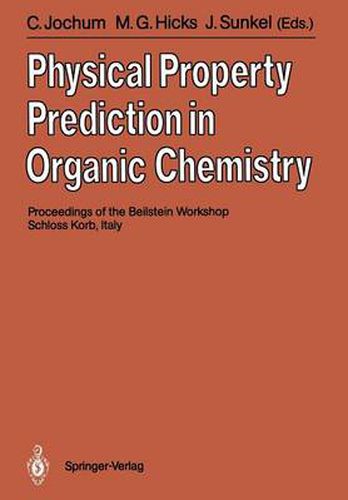Physical Property Prediction in Organic Chemistry: Proceedings of the Beilstein Workshop, 16-20th May, 1988, Schloss Korb, Italy

Physical Property Prediction in Organic Chemistry: Proceedings of the Beilstein Workshop, 16-20th May, 1988, Schloss Korb, Italy
This title is printed to order. This book may have been self-published. If so, we cannot guarantee the quality of the content. In the main most books will have gone through the editing process however some may not. We therefore suggest that you be aware of this before ordering this book. If in doubt check either the author or publisher’s details as we are unable to accept any returns unless they are faulty. Please contact us if you have any questions.
For more than 100 years the Beilstein Handbook has been publishing checked and evaluated data on organic compounds. It has become the major reference book for the chemical and physical properties of organic com pounds. The prediction of these physical properties was the subject of the Beilstein workshop. The ability to predict physical properties is for several reasons of great interest to the Beilstein Institute. It is of primary importance to be able to check the abstracted data for accuracy and to eliminate simple mistakes like typing errors. Presently all the work whether manuscript writing or evaluation of data is carried out manually. This is very time consuming, with the entry of Beilstein into electronic data gathering and publication, the opportunity for computerized consistency checking has become available. Contrary to belief, when one examines the Beilstein Handbook or Chemical Abstracts there is a dearth of chemical information. There are a great many compounds but few are well defined resulting in large gaps in the information available to the chemist. These information gaps could be filled by using algorithmic methods to estimate the properties of interest. An important question to answer is What is the chemist’s reaction to estimated data? Will he accept it for use, within limits defined by the method, or will it be unacceptable and therefore detrimental for the data base. However if one could partly fill gaps in the data base the increase in the power of the search techniques would be marked.
This item is not currently in-stock. It can be ordered online and is expected to ship in 7-14 days
Our stock data is updated periodically, and availability may change throughout the day for in-demand items. Please call the relevant shop for the most current stock information. Prices are subject to change without notice.
Sign in or become a Readings Member to add this title to a wishlist.


